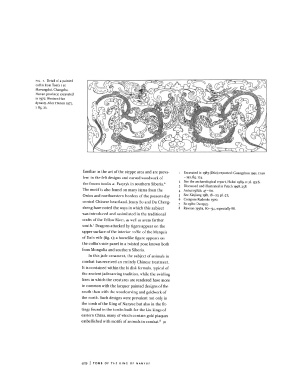Page 420 - The Golden Age of Chinese Archaeology: Celebrated Discoveries from the People’s Republic of China
P. 420
FIG. i. Detail of a painted
coffin from Tomb i at
Mawangdui, Changsha,
Hunan province; excavated
in 1972; Western Han
dynasty. After Hunan 1973,
i: fig. 22.
familiar in the art of the steppe area and are preva- 1 Excavated in 1983 (D62); reported: Guangzhou 1991,1:190
lent in the felt designs and carved woodwork of -192, fig. 124.
the frozen tombs at Pazyryk in southern Siberia. 6 2 See the archaeological report, Hubei 1989, 2: pi. 152:6.
3 Discussed and illustrated in Pruch 1998, 258.
The motif is also found on many items from the 4 Anhui 1982^ 47-60.
Ordos and northwestern borders of the present-day 5 See Xinjiang 1981,18-22, pi. 5:3.
6 Compare Rudenko 1970.
central Chinese heartland. Jenny So and Du Cheng-
7 So 1980; Du 1993.
sheng have noted the ways in which this subject 8 Rawson 19983, 80 - 94, especially 88.
was introduced and assimilated in the traditional
crafts of the Yellow River, as well as areas farther
7
south. Dragons attacked by tigers appear on the
upper surface of the interior coffin of the Marquis
of Dai's wife (fig. i); a horselike figure appears on
the coffin's side panel in a twisted pose known both
from Mongolia and southern Siberia.
In this jade ornament, the subject of animals in
combat has received an entirely Chinese treatment.
It is contained within the hi disk formula, typical of
the ancient jadecarving tradition, while the swirling
lines in which the creatures are rendered have more
in common with the lacquer painted designs of the
south than with the woodcarving and goldwork of
the north. Such designs were prevalent not only in
the tomb of the King of Nanyue but also in the fit-
tings found in the tombs built for the Liu kings of
eastern China, many of which contain gold plaques
8
embellished with motifs of animals in combat. JR
419 | TOMB OF THE KING OF NANYU E

